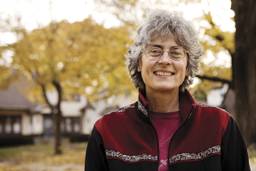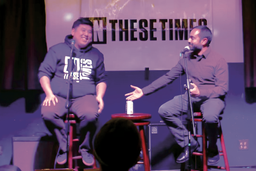Justice Denied
One man stands between Flozelle Woodmore and the “free” world--California Gov. Arnold Schwarzenegger
Silja J.A. Talvi
Last summer, I had the chance to sit down with Flozelle Woodmore in a drab, cafeteria-style visiting room in the Central California Women’s Facility (CCWF), located in the small town of Chowchilla.
At 39 years of age, Woodmore has lived her entire adult life in prison. All of her movements are tracked by her prison number, W-26904. Although she’s long been classified as a trouble-free, minimum-security prisoner, Woodmore is still packed with seven other women – some with maximum-security classifications and serious emotional disorders – in a cell originally designed for two women.
As part of the world’s biggest women’s prison complex, CCWF is home to more than 4,000 female prisoners, with roughly the same number across the street at the Valley State Prison for Women (VSPW). There’s no such a thing as privacy in these grossly overcrowded living conditions; common courtesy is as close as it gets. In the summertime, when temperatures inside the CCWF and VSPW housing units can easily exceed 100 degrees, physical comfort amounts to little more than a pipe dream.
Life in this kind of prison environment is anything but easy. Yet no matter how much worse things have gotten since she was imprisoned at the age of 18, Woodmore has found a way to rise above the madness. In more than 20 years of incarceration, she’s done little but move herself, and the women around her, toward a path of healing and reconciliation from past histories of abuse and addiction.
Woodmore is a strong, emotionally mature woman who usually moves through CCWF’s prison yard with a certain sense of calm and purpose. But on the day when I met her in July 2006, she seemed like a shadow of her usually formidable self. Against the consistent and overwhelming recommendation of the state’s parole board, the California state governor vetoed her release from prison for the fifth, consecutive year.
Woodmore was just 13-years-old when she began a relationship with a man five years her senior, Clifton “Sweet Thing” Morrow, in South Central Los Angeles. As a young teenager, she had sought out love and companionship, but ended up being sexually and physically violated on a regular basis.
“I used to believe it was his right to hit me, force me to have sex,” she explained. “I didn’t feel pretty unless he hit me or forced me to have sex.”
As a young teenager, Woodmore had a child with Morrow. Neither the pregnancy nor her commitment to caring for their child took the bite out of the abuse he heaped on her on a regular basis. With no job skills, economic security, or even a shred of self-esteem, she says today that she could not figure a way out. In truth, Woodmore could not even have gotten a restraining order if she had found the strength to report her boyfriend to the police, as un-emancipated minors cannot obtain them without involvement from a guardian or parent.
To dull the pain of being beaten, stabbed, pushed down a flight of stairs, and convinced of her utter unworthiness, Woodmore turned to alcohol. It wasn’t long before she was a full-blown alcoholic.
At the age of 18, Woodmore sought out protection in the arms of another man. Morrow wasn’t willing to let her go. After Morrow assaulted their two-year-old son, Clifton, Jr., in an attempt to intimidate her back into the relationship, she retaliated by firing a single shot from a .357 Magnum revolver. Morrow died instantly.
Arrested a half-hour later at her mother’s house, Woodmore admitted to the murder immediately, expressing both shock and deep remorse for what she had done. In 1987, her attorney negotiated a second-degree murder plea that carried a 15 years-to-life prison sentence. Robert W. Armstrong, the Superior Court judge overseeing the proceedings, made clear that he believed she would serve “much less” than 15 years before being released back into society.
It’s now 2007, 20 years later after her sentence, and Woodmore is still locked up. Her continued incarceration doesn’t have anything to do with dangerous or troublesome behavior in prison. On the contrary, she’s stayed clear of disciplinary infractions, earned her G.E.D., and taken on the role of counseling other women coming into the system with histories of abuse.
Now, for the sixth year, the state parole board has subjected Woodmore to a battery of interviews, psychological evaluations, and careful review of the 1987 incident that led to her incarceration. At the time of her sentencing, mitigating defense evidence about “intimate partner abuse and its effects” was not taken into account in determining a person’s state of mind – or the severity of a prison term. The first law permitting such evidence was first passed in 2001, as a result of intense community and political pressure. Penal Code 1473.5 gave women convicted of murder of abusive partners before 1992 the opportunity to seek a new trial or reduction in sentence. That change to the legal code was expanded in 2004 to include potential relief for individuals coerced by batterers into committing crimes; individuals convicted of attempted murder or manslaughter in domestic violence situations; and individuals whose convictions could have been altered by evidence of battering.
In her own words, Woodmore has been willing to undergo repeated interrogations “by multiple doctors, public safety investigators, parole commissioners, [California Department of Corrections and Rehabilitation] staff, the [Los Angeles] District Attorney’s office, and other people involved in my case.” And for the sixth straight year, their testimony has led the parole board to recommend her release.
But former Democratic Governor Gray Davis and current Republican Governor Arnold Schwarzenegger have, thus far, ignored the parole board’s previous recommendations and stood by the Los Angeles D.A.’s office, blocking her ability to reintegrate into society.
A July 15 San Francisco Chronicle editorial in support of Woodmore’s parole noted that L.A. Deputy District Attorney David Dahle’s presentation to the parole board opposing Woodmore’s release “seemed also an act of desperation.” Incredibly, Dahle went so far as to suggest that Woodmore’s incarcerated son, whom she has not had custody of since he was a three-year old child, epitomized the “dynamics of violence” inherent to this fractured family. Apparently, the intergenerational traumas so often brought on by cycles of poverty, abuse, and incarceration hadn’t breached Dahle’s pursuit of vengeance.
The State of California has the sixth opportunity to release her from captivity by August 10. Woodmore is praying that Governor Schwarzenegger will give her an opportunity to live life as a woman in the ‘free’ world.
“I was never allowed to pursue happiness,” Woodmore told me. “I [have] not yet been allowed to experience a normal life.”
Woodmore deserves that chance, and she deserves it now.
The San Francisco-based organization, Free Battered Women, has organized a free-of-cost fax campaign to encourage the governor to release Flozelle Woodmore from prison.

I hope you found this article important. Before you leave, I want to ask you to consider supporting our work with a donation. In These Times needs readers like you to help sustain our mission. We don’t depend on—or want—corporate advertising or deep-pocketed billionaires to fund our journalism. We’re supported by you, the reader, so we can focus on covering the issues that matter most to the progressive movement without fear or compromise.
Our work isn’t hidden behind a paywall because of people like you who support our journalism. We want to keep it that way. If you value the work we do and the movements we cover, please consider donating to In These Times.






